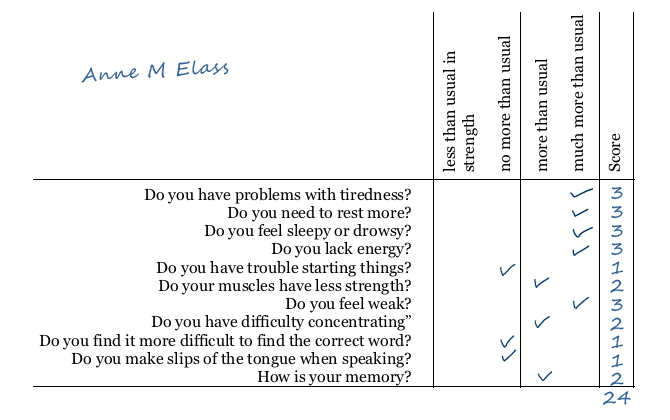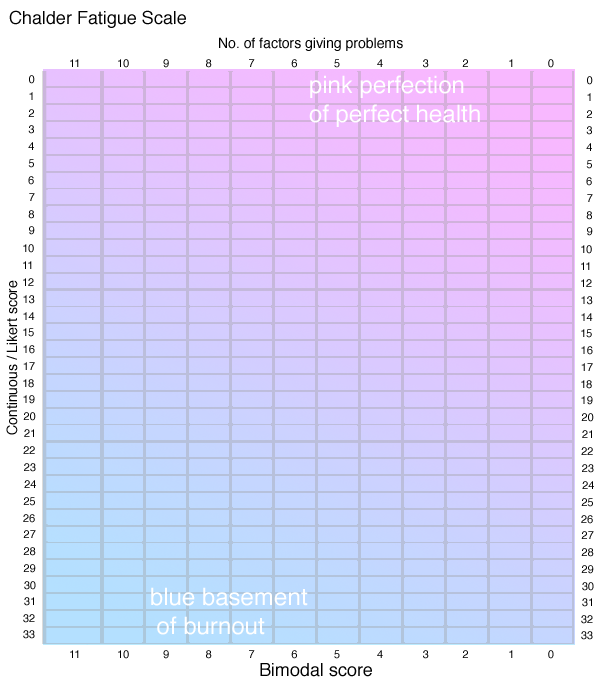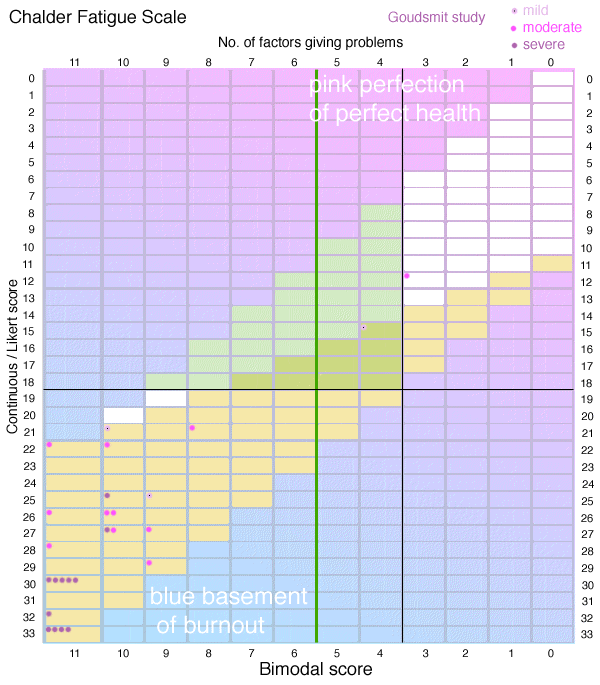There are 11 questions in the Chalder Fatigue Scale, as used in the PACE trial:-
 Do you have problems with tiredness? Do you have problems with tiredness?- Do you need to rest more?
- Do you feel sleepy or drowsy?
- Do you have problems starting things?
- Do you lack energy?
- Do your muscles have less strength?
- Do you feel weak?
- Do you have difficulty concentrating?
- Do you make slips of the tongue when speaking?
- Do you find it more difficult to find the correct word?
- How is your memory?
and asks if the factor is
- less (of a problem) than usual
- no more than usual
- more than usual
- much more than usual
In the PACE trial patients were asked to respond comparing their present state with when they were last well.
Bimodal scoring allocates 0, 0, 1 and 1 to each of these answers, which would give a score of 0 to someone who was perfectly healthy, down to a maximum of 11. In effect, Bimodal scoring simply counts how many of these factors are affected by the illness.
Continuous, or Likert scoring allocates 0, 1, 2, and 3 to these answers, with scores from 0 to 33.
In our survey (more details in section 6) many people commented on the difficulty of quantifying the difference between more and much more. A factor that would be considered by any normal healthy person to be severe can get even worse in a bad spell. They considered that at least one more level, extreme, scoring 4, would have been appropriate. There is a study by Goudsmit et al. looking at the limitations of both scoring methods.
The PACE Trial
Originally, as shown in the protocol, the trial was to have used bimodal scoring, specifying that a positive outcome would be a 50% reduction in fatigue score, or a score of 3 or less. A score of 4 or more would show abnormal fatigue.
Later, after the trial had started, the scoring was changed from Bimodal to Likert/continuous, and a positive outcome was re-defined as a score of 18 or less. This change has led to unease among some scientists who regard a change of an agreed protocol as being acceptable only under very special circumstances.
Difficulties with the Continuous Scoring
It puzzles us how any patient could say that their symptom had become less of a problem than it had been when they were fully healthy. That would mean that a score of zero for any component is very unlikely (although from other studies there are occasional scores which suggest that patients must have scored zero on some components, and we have found subsequently on our own survey that there are rare circumstances that permit this to happen). It would make more sense if patients had been asked to compare themselves with healthy friends of the same age, but this is not the case.
One of the entry conditions was that patients had to score 6 or more under the bimodal system - i.e. they had 6 or more factors that gave them difficulties. Subsequently 18 was used on the Likert scale as a boundary for returning to normal health.
In a relatively small study, looking at cortisol levels in CFS, the Likert scale was used to assess fatigue levels in 40 patients and 40 controls. The patients scored 24·4 ± 2·9, and the healthy controls 7·6 ± 2·3 (which of course means that the healthy controls generally marked 3 or 4 of the items as being less of a problem than usual). A much larger Norwegian study gave a value of 11.2 as a score for healthy adults. Clearly, the use of a score of 18 to mark "normal function" is, at best, overgenerous, but the differences between the results of different studies prompts the question "Is the Likert scale fit for purpose?"
Start with the patient below:-
|






 Do you have problems with tiredness?
Do you have problems with tiredness?